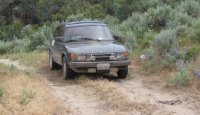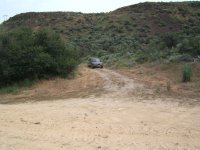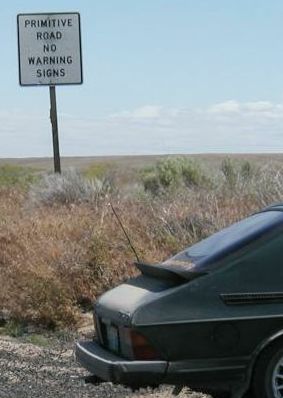So what the heck is a CP?
The checkpoints referenced in the previous entry, called a CP for short, are where the workers on a rally time the competitor cars when they go by. The goal of the TSD rallies we like to compete in and organize is to stay on time all the time. The competition is to see how well that can be done given a route to drive and speeds t o maintain. The organizers meticulously measure the route, and a "perfect" time can be given for any mileage. The entrants don't know where the CPs are located, so they have to strive to stay as perfect as possible. Different classes mean different levels of competition. So folks running SOP, or Seat of the Pants class, are working with the stock odometer and pencil and paper to figure out what time they're supposed to be where. Those in Equipped class get to use an auxiliary odometer and can use any sort of computer or calculator as long as it's not connected to the odometer. And the ones who should turn in the best scores are in Unlimited class, where they can use specialized computers that take the odometer input and combine with the speed changes entered at mileages by the navigator to give the team a constant update on how early or late they are. If you pass a CP too early for your perfect time, you get a point for every second that you're early. If you're late, you get a point for every second you're late, up to a maximum amount (usually two or three minutes, sometimes five).
o maintain. The organizers meticulously measure the route, and a "perfect" time can be given for any mileage. The entrants don't know where the CPs are located, so they have to strive to stay as perfect as possible. Different classes mean different levels of competition. So folks running SOP, or Seat of the Pants class, are working with the stock odometer and pencil and paper to figure out what time they're supposed to be where. Those in Equipped class get to use an auxiliary odometer and can use any sort of computer or calculator as long as it's not connected to the odometer. And the ones who should turn in the best scores are in Unlimited class, where they can use specialized computers that take the odometer input and combine with the speed changes entered at mileages by the navigator to give the team a constant update on how early or late they are. If you pass a CP too early for your perfect time, you get a point for every second that you're early. If you're late, you get a point for every second you're late, up to a maximum amount (usually two or three minutes, sometimes five).
Location of a CP is determined by the rallymaster and whoever is assisting with the course layout. They are usually placed where it's not easy for the competitors to see where the CP crew is waiting, and often at the end of a twisty bit of road, or a hill climb or des cent. In our events, entrants don't stop at the CP -- they're timed as they pass. Experienced crews will note what they think is their score at a CP location, assuming they can tell where the timing point is located, such as a fencepost, cattle guard or other permanent and immobile marker. It's amusing to watch navigators crane their necks as they pass every side road, trying to spot CP crews, and when they find one, they jerk for their clock and notes for tracking their progress.
cent. In our events, entrants don't stop at the CP -- they're timed as they pass. Experienced crews will note what they think is their score at a CP location, assuming they can tell where the timing point is located, such as a fencepost, cattle guard or other permanent and immobile marker. It's amusing to watch navigators crane their necks as they pass every side road, trying to spot CP crews, and when they find one, they jerk for their clock and notes for tracking their progress.
Sometimes it's good to hide, like during a mundane section where drivers may get a little lax about staying on time. Other times it's good to be spotted, so the driver and navigator know that they're late or early after a challenging stretch of road. In the photos here, I'm located at the top of a twisty hill climb near the beginning of a TSD section. I'm visible, but only when the cars pass, from left to right. Not quite camouflaged, but the green paint spotted with mud is a good start.
 o maintain. The organizers meticulously measure the route, and a "perfect" time can be given for any mileage. The entrants don't know where the CPs are located, so they have to strive to stay as perfect as possible. Different classes mean different levels of competition. So folks running SOP, or Seat of the Pants class, are working with the stock odometer and pencil and paper to figure out what time they're supposed to be where. Those in Equipped class get to use an auxiliary odometer and can use any sort of computer or calculator as long as it's not connected to the odometer. And the ones who should turn in the best scores are in Unlimited class, where they can use specialized computers that take the odometer input and combine with the speed changes entered at mileages by the navigator to give the team a constant update on how early or late they are. If you pass a CP too early for your perfect time, you get a point for every second that you're early. If you're late, you get a point for every second you're late, up to a maximum amount (usually two or three minutes, sometimes five).
o maintain. The organizers meticulously measure the route, and a "perfect" time can be given for any mileage. The entrants don't know where the CPs are located, so they have to strive to stay as perfect as possible. Different classes mean different levels of competition. So folks running SOP, or Seat of the Pants class, are working with the stock odometer and pencil and paper to figure out what time they're supposed to be where. Those in Equipped class get to use an auxiliary odometer and can use any sort of computer or calculator as long as it's not connected to the odometer. And the ones who should turn in the best scores are in Unlimited class, where they can use specialized computers that take the odometer input and combine with the speed changes entered at mileages by the navigator to give the team a constant update on how early or late they are. If you pass a CP too early for your perfect time, you get a point for every second that you're early. If you're late, you get a point for every second you're late, up to a maximum amount (usually two or three minutes, sometimes five).Location of a CP is determined by the rallymaster and whoever is assisting with the course layout. They are usually placed where it's not easy for the competitors to see where the CP crew is waiting, and often at the end of a twisty bit of road, or a hill climb or des
 cent. In our events, entrants don't stop at the CP -- they're timed as they pass. Experienced crews will note what they think is their score at a CP location, assuming they can tell where the timing point is located, such as a fencepost, cattle guard or other permanent and immobile marker. It's amusing to watch navigators crane their necks as they pass every side road, trying to spot CP crews, and when they find one, they jerk for their clock and notes for tracking their progress.
cent. In our events, entrants don't stop at the CP -- they're timed as they pass. Experienced crews will note what they think is their score at a CP location, assuming they can tell where the timing point is located, such as a fencepost, cattle guard or other permanent and immobile marker. It's amusing to watch navigators crane their necks as they pass every side road, trying to spot CP crews, and when they find one, they jerk for their clock and notes for tracking their progress.Sometimes it's good to hide, like during a mundane section where drivers may get a little lax about staying on time. Other times it's good to be spotted, so the driver and navigator know that they're late or early after a challenging stretch of road. In the photos here, I'm located at the top of a twisty hill climb near the beginning of a TSD section. I'm visible, but only when the cars pass, from left to right. Not quite camouflaged, but the green paint spotted with mud is a good start.


0 Comments:
Post a Comment
Links to this post:
Create a Link
<< Home